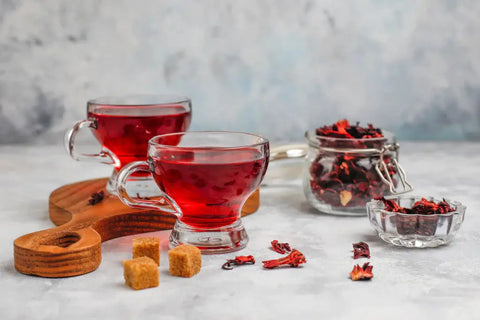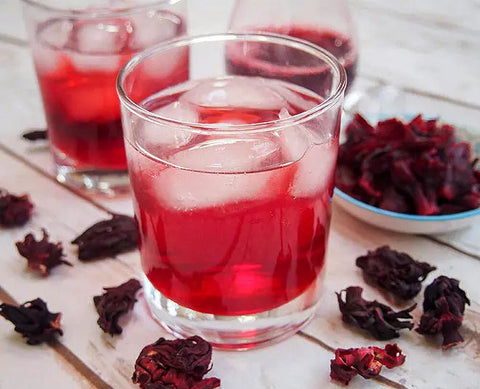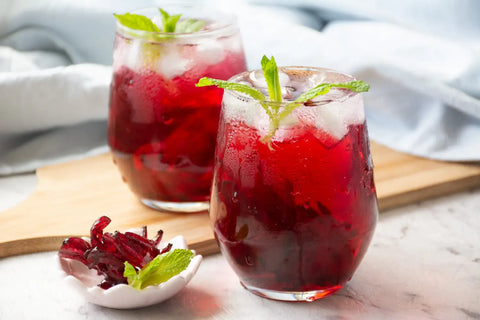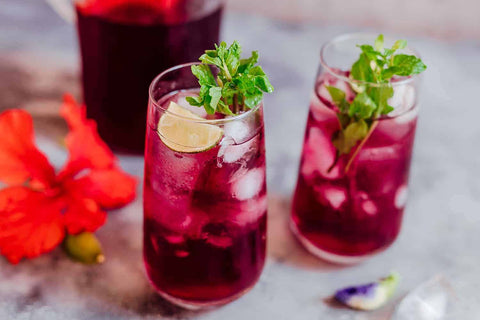The Health Benefits of Hibiscus Tea
How to Make Hibiscus Tea: A Comprehensive Guide
Hibiscus tea is a delicious and refreshing beverage that has been enjoyed for centuries. Made from the dried petals of the hibiscus flower, this tea has a tart and tangy flavor that is both refreshing and invigorating.
In addition to its great taste, hibiscus tea also has several health benefits, including lowering blood pressure, boosting immunity, and aiding digestion. In this article, we will guide you on How to Make Hibiscus Tea, step by step.

How to Make Hibiscus Tea: A Comprehensive Guide
1. Discovering the Benefits of Hibiscus Tea
2. How to Make Delicious and Healthy Hibiscus Tea
2.1 How To Make Hibiscus Tea With Fresh Flowers
2.2 How To Make Hibiscus Tea With Dried Flowers
3. Tips for Brewing the Perfect Cup of Hibiscus Tea
4. Does Hibiscus Tea Make You Sleepy?
5. Conclusion
1. Discovering the Benefits of Hibiscus Tea
Before we dive into the process of making hibiscus tea, let's take a closer look at the health benefits associated with this delicious beverage. Here are some of the key benefits of drinking hibiscus tea:
- Lower Blood Pressure: Those with hypertension have demonstrated to experience decreased blood pressure after drinking hibiscus tea.
- Rich in Antioxidants: Hibiscus tea is loaded with antioxidants, which help to protect your body from free radicals and prevent cell damage.
- Boosts Immunity: Vitamin C, which is vital for a strong immune system, is abundant in hibiscus tea.
- Aids in Digestion: The natural laxative properties of hibiscus tea can aid in improving digestion and relieving constipation.
2. How to Make Delicious and Healthy Hibiscus Tea
Now that we have discussed the benefits of hibiscus flower tea, let's take a closer look at how to make this delicious beverage. Here are the step-by-step instructions on how to make hibiscus tea with fresh flowers and with dried flowers:
2.1 How To Make Hibiscus Tea With Fresh Flowers
Step 1: Gather the ingredients
The first step is to gather all the components. 6 to 8 fresh hibiscus flowers, 4 cups of water, a pinch of honey or sugar, and lemon or lime wedges are required (optional).
Step 2: Clean and prepare the flowers
Remove the stamens and pistils from the fresh hibiscus flowers and rinse them thoroughly under cold water to remove any dirt or debris.
Step 3: Boil the water
In a pot, bring four cups of water to a boil. For the greatest results, choose a premium pot with a tight-fitting lid.
Step 4: Add the flowers to the pot
Once the water is boiling, add the cleaned hibiscus flowers to the pot and reduce the heat to low.
Step 5: Simmer the tea
Simmer the tea for 10-15 minutes, stirring occasionally.
Step 6: Strain the tea
Remove the pot from the heat and strain the tea into a pitcher or teapot using a fine-mesh strainer.

2.2 How To Make Hibiscus Tea With Dried Flowers
Making hibiscus tea with dried flowers is the more common method. Here are the steps to make hibiscus tea with dried flowers:
Step 1: Gather the ingredients
The initial step entails gathering all the components. 4 cups of water, 1/2 cup of dried hibiscus petals, and lemon or lime wedges are the ingredients you'll need.
Step 2: Boil the water
After that, heat up a pot with four glasses of water. For maximum results, use a pot of excellent construction with a tight-fitting lid.
Step 3: Add the hibiscus petals to the pot
Once the water is boiling, add 1/2 cup of dried hibiscus petals to the pot and remove it from the heat.
Step 4: Steep the tea
Let the mixture steep for 10-15 minutes. This will allow the hibiscus petals to infuse the water with their flavor and nutrients.
Step 5: Strain the tea
Strain the tea into a pitcher or teapot using a fine mesh strainer or cheesecloth to remove the hibiscus petals. If you prefer a stronger tea, you can steep the hibiscus petals for a longer period.

3. Tips for Brewing the Perfect Cup of Hibiscus Tea
While making hibiscus tea is relatively straightforward, there are a few tips that can help you brew the perfect cup. Keep in mind the following advice:
3.1 Use high-quality hibiscus flowers
The quality of the hibiscus flowers will affect the taste and flavor of the tea. Look for high-quality dried hibiscus flowers that are bright red and free of dust and debris. Visit The Rike to purchase hibiscus flowers or petals labeled for making tea and ensure the quality and authenticity of your hibiscus tea.
3.2 Use fresh water
Always use fresh, cold water when brewing hibiscus tea. If your water is not fresh, it can affect the taste of the tea.
3.3 Steep the tea for the right amount of time
The ideal steeping time for hibiscus tea is 10-15 minutes. If you steep the tea for too long, it may become bitter. Tea may be weak if it isn't steeped for a sufficient amount of time.
3.4 Strain the tea properly
Use a fine mesh strainer or cheesecloth to strain the tea and remove the hibiscus petals. This will ensure that the tea is smooth and free of any debris.
3.5 Sweeten to taste
Add honey or sugar to the tea according to preference. Start with a tiny amount and increase it as necessary. The sweetener must be well dissolved while stirring.
3.6 Add lemon or lime wedges (optional)
For a refreshing twist, you can add lemon or lime wedges to the tea. This will give it a slightly tart flavor and add some extra Vitamin C.
3.7 Serve hot or chilled
You can enjoy hibiscus tea hot or chilled. If you want to chill it, simply let it cool to room temperature and then refrigerate it until it's cold.

4. Does Hibiscus Tea Make You Sleepy?
Hibiscus tea is not known to make people feel sleepy. In fact, it is often consumed for its energizing and refreshing qualities. Hibiscus tea contains caffeine, although in much lower amounts than coffee or black tea, which can provide a mild boost of energy.
Additionally, hibiscus tea contains antioxidants and vitamin C, which can help to promote alertness and reduce fatigue. However, it is worth noting that individual responses to caffeine can vary, and some people may experience drowsiness or other side effects from consuming caffeine. If you are particularly sensitive to caffeine, it is best to consume hibiscus tea in moderation or opt for a caffeine-free version.
5. Conclusion
In conclusion, hibiscus tea is a flavorful and healthy beverage that can be enjoyed hot or cold, sweetened or unsweetened. By following the simple steps of how to make hibiscus tea and using high-quality hibiscus flowers, you can easily brew the perfect cup and enjoy its many potential benefits. So, try making a cup of hibiscus tea today and discover its delicious taste and health benefits for yourself.





Leave a comment